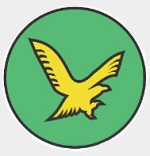Hobby Master HA4410 Israeli Defense Force Lockheed-Martin F-35A "Adir" Joint Strike Fighter - 140 Squadron "Golden Eagle", Nevatim Airbase, Beersheba, Israel, December 2017 [Low-Vis Scheme] (1:72 Scale)
"The F-35 is the fighter plane of the future that will allow Israel to maintain its aerial superiority and its technological advantage in the region... The F-35 will give the IAF better capabilities, both near and far, to help strengthen Israel's national security."
- Israeli Defense Minister Ehud Barak
 The Lockheed Martin F-35 Lightning II is a fifth-generation, single-seat, single-engine, stealth-capable military strike fighter, a multirole aircraft that can perform close air support, tactical bombing, and air superiority fighter missions. The F-35 has three different models; one is the conventional takeoff and landing variant, the second is short takeoff and vertical-landing variant, and the third is a carrier-based variant.
The Lockheed Martin F-35 Lightning II is a fifth-generation, single-seat, single-engine, stealth-capable military strike fighter, a multirole aircraft that can perform close air support, tactical bombing, and air superiority fighter missions. The F-35 has three different models; one is the conventional takeoff and landing variant, the second is short takeoff and vertical-landing variant, and the third is a carrier-based variant.
The F-35 is descended from the X-35, the product of the Joint Strike Fighter (JSF) program. Its development is being principally funded by the United States, with the United Kingdom, and other partner governments providing additional funding. It is being designed and built by an aerospace industry team led by Lockheed Martin with Northrop Grumman and BAE Systems as major partners. Demonstrator aircraft flew in 2000, with the first flight on December 15th, 2006.
Israel has gone ahead with an initial buy anyway, while negotiating to add key items. Israeli "F-35i Adir" fighters will include compatible communications systems and datalinks, and provisions to insert some locally-built ECM and defensive electronics.
Israel will also want to broaden the plane's weapons array to include Israeli weapons, as a subject of future agreements. Items mentioned in reports to date include Python short-range air-to-air missiles, and dual-mode guidance Spice GPS/IIR smart bombs. Those items are still being negotiated, and Israel's top-of-the-line strike fighter will need even more weapons than these in order to be fulfill its role.
Pictured here is a 1:72 scale replica of an Israeli Defense Force Lockheed-Martin F-35A "Adir" Joint Strike Fighter that was attached to the 140 Squadron "Golden Eagle", then deployed to Nevatim Airbase, Beersheba, Israel, during December 2017.
Sold Out!
Dimensions:
Wingspan: 5-3/4-inches
Length: 8-1/2-inches
Release Date: December 2017
 Historical Account: "Replacing Lions" - Israel didn't get everything it wanted in its initial buy, and ended up paying considerably more than it had expected. On the other hand, it did get the USA to move on the subject of ECM defensive systems as of 2010, and may succeed in getting more changes made.
Historical Account: "Replacing Lions" - Israel didn't get everything it wanted in its initial buy, and ended up paying considerably more than it had expected. On the other hand, it did get the USA to move on the subject of ECM defensive systems as of 2010, and may succeed in getting more changes made.
On the seller's side of the table, Israel's buy is a respected vote of confidence that the F-35 needs. Lockheed Martin is trying to ramp up orders for the F-35 quickly, even though the aircraft are now expected to remain in testing until 2018. A large order book would allow the firm to offer early buyers much lower prices for each plane, using dollar averaging over a substantial initial batch, instead of charging $130 - $170 million for early production aircraft, and $100 million or so for the same plane 3 years later.
That wide difference in purchase costs is standard for military aircraft of all types, but the F-35 is about 5-7 years late versus its ideal market window. Worse, American budgets are already slowing orders, with over 150 planned fighters removed from the latest 5-year plan. Potential customers with air fleets that are reaching their expiry dates are reluctant to pay those high early production costs. If enough of them defect, the F-35 program as a whole could find itself in trouble. By adding an Israeli endorsement, and adding orders during a critical period for the program, Israel's 20-plane order assumes an importance out of proportion to its size.
The final leverage point for Israel is its solid commitment to its fighter force, and known need for future upgrades. Over time, 326 F-16s have to be replaced with something, and an early order puts the F-35 in a strong competitive position for further orders. If volume purchases from other countries can help drive costs down closer to $80 million, and new approaches can beat current estimates of high F-35 operating and maintenance costs, the F-35 could become very hard to compete against.
Beyond the F-16s, The IAF's F-15 Eagles will also require replacement in the coming years, which will be a competition all its own. If the F-35 falters, sharply closer defense relations with Italy could turn the Eurofighter into an option, and Boeing is spending private funds to develop a stealth-enhanced F-15SE "Silent Eagle." The F-15SE would offer longer range, twin engines for reliability, a much wider set of integrated weapons, and IAF fleet commonalities, in exchange for less stealth than the F-35. If costs are even close to equivalent, the F-35 will have a serious competitor.





 F-35A Review
F-35A Review 









